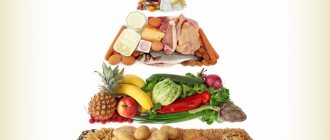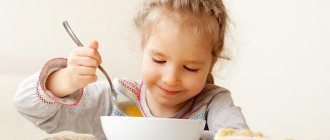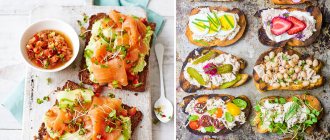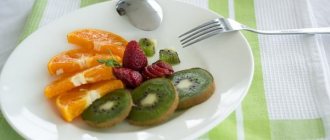Principles and rules of diet for children
When starting to create a menu for a child, you need to adhere to a number of rules. They will make the diet as effective as possible.
- A child needs vitamins, minerals and other useful substances, which he can only get from food. It is important that the menu is not devoid of fats, proteins and carbohydrates. Deficiency of nutrients is unacceptable.
- A child should not experience hunger that is unacceptable to him.
- A child should not be allowed to be completely deprived of sweets, despite the fact that he is on a diet. However, they should be useful.
- A children's diet cannot be strict. This is contrary to all medical principles. There are no indications for a strict diet for children.
The principles on which any children's diet is built:
- A balanced menu, with an emphasis on protein products. They should be at least 50% in the daily diet.
- Compliance with the caloric content of dishes according to the age characteristics of the body.
- Lack of foods on the menu that contribute to weight gain.
In addition to all of the above principles and rules for creating a children's diet, it is also necessary to take into account the following recommendations:
- You need to eat 5-6 times a day.
- During the day you need to distribute products correctly:
- At breakfast, the child should eat 25% of the daily diet.
- During lunch – 10%.
- Lunch accounts for 40%.
- For afternoon tea – 5%.
- At dinner he eats 20% of the entire menu offered.
- Before lunch, the menu should be dominated by protein products, and in the evening - vegetables and cereals.
- You can’t eat a lot without following a regimen.
- Children should eat foods that are gently cooked. You can steam, bake, stew and boil.
If there are no medical indications, then a child under 5 years of age cannot be allowed to follow a diet. Limiting the food supply can lead to a failure in the absorption of nutrients, disrupt metabolism, and therefore provoke excess body weight gain. A young child should eat properly and should not be offered unhealthy foods or sweet carbonated water.
Baby food: rules and features
Content:
- Baby food: rules and features
- Universal diet for children
- Diet for children with allergies
- Diet for rotavirus infection
- Diet for overweight children
When planning your child's diet, you should take into account several general rules. They are the basis of the most effective diet for children.
First of all, do not forget that a growing body’s need for nutrients is an order of magnitude higher than that of adults, so the basis of baby food should be natural products. In addition, the metabolic rate in children is one and a half to two times higher than in adults.
Therefore, in order for the baby to grow, develop mentally and physically, build muscle mass and fully use his potential, the energy value of his daily diet must be at least 10% higher than his energy expenditure.
Parents should take into account that children do not yet have the skills and motivations that would push them to make conscious healthy eating choices, therefore, it is the responsibility of adults to develop healthy eating habits in children. Moreover, parents should instill in their children a love of healthy eating by their own example.
In addition, you need to listen to the general recommendations of nutritionists:
- No coercion! You should not force your child to sit at the table just because it is “usual” lunch or dinner time. No food will be used for future use “to the accompaniment” of the hysteria and tears of a child who has been torn away from the game.
- Do not “feed” your child when he is sick. During this period, all the forces of his body are aimed at fighting the disease; therefore, force-feeding is prohibited. When forming a diet for a sick child, one should be guided solely by his appetite.
- Refuse to eat rich and high-calorie foods in favor of fractional meals, that is, in small portions five to six times a day.
- Protein foods should be present in the child's diet daily. At the same time, you shouldn’t get too carried away - an excess of proteins is just as dangerous as their lack.
- Fermented milk products should be given to children as a separate meal and not in combination with other foods.
Permitted and prohibited products
Products that are allowed to be eaten during the children's diet:
- Meat: beef, rabbit, turkey, nutria, chicken, offal, homemade liver pate.
- Chicken eggs, quail eggs.
- Cereals: oatmeal, buckwheat, rice, millet, pearl barley, corn grits.
- Legumes, vegetables, greens.
- Milk and fermented milk drinks and products.
- Berries and fruits.
- Rye bread, bran bread.
- Fresh juices made from fresh fruits, nectars, fruit drinks, jelly, uzvar, cocoa, green tea, herbal decoction, rosehip infusion, still mineral water.
Products that a child can consume in limited quantities:
- Chocolate, marmalade and marshmallows.
- Vegetable oil used for salad dressing.
- You can add butter to porridge.
Sweet foods should be given to the child in the first half of the day and in small quantities.
Products that are prohibited from using when compiling a children's menu:
- Smoked meats.
- Canned food.
- Baked goods, sparkling water.
- Semi-finished products.
- Sausages.
- Fast food.
- Fried pies.
- Crackers, nuts and chips.
Should children be forced to eat?
How can you convince your child to eat healthy food if he refuses? There is a huge gap between persuasion and compulsion to eat. When a mother convinces, she is not offended by the child’s refusal and does not demand that he continue eating.
“Until you eat everything, you won’t leave the table”—familiar words? It is clear that our grandmothers simply had no choice, but there is no point in continuing this tradition of food tyranny.
Yes, it’s a shame when a lovingly prepared dinner remains on the plate practically untouched. It seems that the child neglects our care - all the effort that was spent on obtaining food and preparing it. And as if overcome by spirits from a distant Soviet childhood, we furiously repeat the words of our grandmother: “So many people are starving, and you! Mom and dad are trying, working, but you are wandering around! If you don’t eat, you’ll remain small and weak!”
But think better about the fact that such words are dictated not by care, but by a selfish feeling of resentment for the fact that our love and care were rejected.
According to many studies, there is a connection between a child's upbringing and eating disorders in his adult life. Parents around the world behave in similar ways, but justify food pressure differently.
In the West, adults are guided by the fact that it is “tasty”, “healthy”, “expensive” and “should be eaten fresh”, and in countries such as Mauritania, a mother will be ashamed of her skinny child, since all the neighbors their family will be considered poor. This is especially true for girls, who in Arab villages are still fattened up to the standards of the 1001 Nights fairy tales, according to which a woman’s navel should “hold an ounce of peanut butter.”
The harmful consequences of forced eating: food as comfort.
But eventually, obedient children stop eating because they are hungry and begin to use food for other purposes. The food eaten turns out to be a way to earn mom's praise and thus experience pleasure. And in their adult lives, they will also turn to food to comfort themselves when they are stressed or sad.
Unfortunately, too much control on the part of parents regarding nutrition very often leads to similar results. The same applies to prohibitions on harmful products: the child stops perceiving them as food and sees in them only an inaccessible pleasure. When we force a baby to eat a healthy product, which he persistently refuses, he again ceases to perceive it as food. For him, this forever remains a lost battle, in which he was defeated by a stronger opponent.
72% of people who were forced to eat specific healthy foods as children eliminated them completely from their diets as adults.
Sample menu for a week's diet for children
The proposed menu is balanced. It allows you to lose 1 kg of weight in a week, and there will be no harm to children’s health. During the diet, it is important to ensure that the child drinks enough water and also engages in physical activity.
| Diet day | Breakfast | Snack | Dinner | Dinner |
| 1 | Steam omelet based on 1 egg, skim milk and rice, fresh apple | Wholemeal toast with butter, low-fat cheese, cucumber, compote with dried fruits | Steamed potatoes, steamed chicken liver, greens, fresh carrots | Muesli, salad with boiled beets and walnuts with sour cream dressing, cocoa |
| 2 | Pancakes with semolina, apple, green tea with lemon | Greek salad, boiled egg, fresh orange | Soup with meatballs and buckwheat, whole grain toast | Cabbage-carrot salad with grated apple and sour cream, fruit jelly |
| 3 | Salad with boiled rice, egg and squid, pomegranate juice | Steamed fish balls, milkshake with strawberries and bananas | Fish soup, stewed cabbage with chicken hearts, berry juice | Rice porridge with raisins, fruit salad with yogurt, orange juice |
| 4 | Steam omelette with mushrooms, chicken fillet and celery, whole grain toast, green tea | Cottage cheese with fruit | Borscht with chicken, vinaigrette, fresh apple | Muesli, berry jelly and pear |
| 5 | Pumpkin porridge and uzvar | Baked apple, berries | Green borscht with beef, salad with fresh vegetables, orange juice | Corn porridge with raisins, yogurt |
Three recipes for children's breakfast
Cottage cheese casserole
Ingredients:
- 200 g cottage cheese;
- 1 egg;
- 1 tsp Sahara;
- oatmeal as much as you need;
- baking powder.
Mix flour with baking powder, add cottage cheese, sugar, and egg. Instead of a whole egg, you can use only the white, this will reduce the fat content and calorie content of the dish. Place in the pan and bake for 20-30 minutes, depending on the size of the pan and the thickness of the casserole, at 1800C.
cottage cheese casserole
Fruit smoothie
Ingredients:
- green tea;
- apple;
- banana;
- kiwi.
Mix all ingredients in a blender, adjust thickness with green tea.
fruit smoothie
Granola
Ingredients:
- 2 bananas;
- 200 g oatmeal;
- a handful of nuts (any);
- 3 tbsp. honey;
- 3 tbsp. olive oil;
- a pinch of salt;
- a packet of vanilla sugar.
Mash the bananas, add honey and olive oil, then oatmeal, nuts, salt, vanillin. Mix everything thoroughly. Line a baking sheet with parchment and smooth the resulting mixture on top. Preheat the oven to 1600C and bake the mixture for 10-15 minutes. Stir the granola every 2-3 minutes so that it does not burn, but is slightly browned.
granola
Delicious recipes
Pilaf with dried fruits
- You can take any dried fruit in a volume of 150 g. This can be prunes, dates, dried apricots or raisins. You will also need 0.3 kg of nuts - cashews, almonds or walnuts.
- Rice should be long grain, its volume is 0.7 kg. Soak the rice for an hour in salted hot water.
- When the rice can be easily crushed with your fingernail, it is ready for further processing. If the cereal is too hard, then drain the water and pour boiling water over the rice again.
- While the rice is being prepared, finely chop the carrots and cut the onions into feathers.
- Onions are fried in vegetable oil until golden brown.
- Carrots are fried in butter.
- Place onions, rice, carrots in a cauldron, fill with water so that its level rises one finger above the rice. Salt the dish, add barberry and cumin.
- Do not cover the cauldron; cook the pilaf over high heat until all the liquid has evaporated.
- Dried fruits and nuts are fried in a frying pan with butter, placed in a cauldron with rice and covered with waffle towels and then with a lid.
- After 30 minutes the pilaf will be ready, it needs to be mixed and served.
Minestrone
- Finely chop the red onion and garlic clove.
- Cut 2 carrots, 2 celery trunks, a fennel tuber, 1 potato into cubes.
- Divide the leek into 2 halves, wash it thoroughly and cut it into slices 1 cm thick.
- Using a blender, grind 0.8 kg of canned tomatoes in their own juice.
- Fry zucchini, leeks, garlic, carrots, celery, and 1/4 teaspoon of dried oregano in olive oil. Then cover with a lid and simmer for another 15 minutes.
- Add potatoes, tomatoes and vegetable broth in an amount of 1 liter to the vegetables.
- Cook the soup for another 30 minutes.
- Cut 1 tomato, 1 zucchini and 1 sweet pepper into cubes, add them to the soup 10 minutes before the end of cooking. Along with the vegetables, add a can of canned beans to the dish.
- The soup is salted and peppered, served with basil leaves and grated Parmesan.
Soufflé with rabbit meat
- Boil 0.2 kg of rabbit meat.
- Soak 80 g of white bread crumb in milk.
- The meat and bread are passed through a blender, 4 chicken eggs are added to it and ground again.
- Fill muffin tins with minced meat and place on a baking sheet with water.
- Bake in the oven for a quarter of an hour at a temperature of 180 °C.
- Soufflé is eaten both hot and cold.
Fish quenelles
- Grind 0.35 fillets of low-fat white fish in a meat grinder.
- Dry the flour (2 teaspoons) in a frying pan, pour milk into the frying pan, stirring constantly so that no lumps form, and add salt.
- Add this sauce to minced fish. The yolk and separately beaten white are introduced there.
- Form the minced meat into balls and cook them until fully cooked.
- Separately, prepare the sauce for the quenelles: peel the peaches, remove their pits, and fry the onions with garlic and dried paprika in olive oil. After 5-8 minutes, add 3 tablespoons of lemon juice, 2 tablespoons of sugar to the onion, salt and pepper, fry for another 5 minutes, then add peaches to the pan and cook for 5-10 minutes. If the sauce turns out to be very thick, it can be diluted with water.
- When the sauce is ready, it is passed through a blender and served with the quenelles.
Soba noodle soup
- Soak 2 sheets of dried seaweed in 4 glasses of cold water for 20 minutes, boil the water and reduce the heat.
- Add 30 g of fish chips to the pan, cook for a few more minutes, strain the broth through cheesecloth.
- Separately, boil the soba noodles, following the instructions on the package, and rinse the finished noodles in cold water.
- Boil the eggs and peel them.
- Chopped champignons, a bunch of bok choy, and shrimp are added to the boiling broth left over from the seaweed.
- Place soba noodles on a plate, an egg cut into 2 parts, pour in broth, add bok choy.
- Garnish the soup with sesame seeds and green onions.
Possible contraindications to weight loss diets
There are a number of contraindications for following a diet in childhood.
Low-calorie nutrition is unacceptable during exacerbation of diseases of the gastrointestinal tract, including:
- gastritis;
- colitis;
- enteritis;
- pancreatitis, etc.
In addition, switching a child to a low-calorie diet for type 1 diabetes is extremely dangerous.
To suppress the disease, children are given injections of insulin, which helps break down fat deposits. It is necessary to transfer the child to specialized nutrition, which involves counting carbohydrates and bread units. Diets for weight loss are contraindicated if heart and vascular diseases have been previously diagnosed. In this case, the cardiologist prescribes a special diet for the child. It is unacceptable to use diets to reduce body weight if the child has benign or malignant tumors. With such disorders, a nutritious diet is required that will enhance the body's defense mechanisms. A deficiency of nutrients can aggravate the situation and provoke the growth of tumors. You need to adhere to the menu recommended by the oncologist.
In addition, following a diet to normalize body weight is contraindicated if the child has a predisposition to allergic reactions.
Therapeutic diets for children
Diet for children with allergies
If a child suffers from allergies grows up in a family, then he needs to follow a certain diet. Otherwise, the baby will be plagued by such health problems as: urticaria, allergic rhinitis, diathesis, conjunctivitis.
However, despite the fact that the child needs to adhere to dietary nutrition, his diet must be complete. Parents should definitely know which foods are more allergenic and which are less allergenic.
Thus, the products that most often cause allergic reactions include: eggs and milk, citrus fruits, berries (raspberries, strawberries, strawberries), wheat and rye, chocolate, coffee, honey, cocoa, nuts.
Products that have an average allergenic potential: potatoes, legumes, beets, apricots, peaches, bananas, blueberries, black currants.
The menu of a child with allergies should be based on products such as:
- Fermented milk drinks and products.
- Meat: low-fat pork, lamb, turkey, rabbit, horse meat.
- Green apples and pears.
- Dill and parsley.
- White and cauliflower cabbage, cucumbers and zucchini, yellow cherries.
The products on this list have minimal allergenic potential, so they can be offered to a child with allergies.
Read more: Diet for allergies
For rotavirus infection
Rotavirus infection (intestinal flu) is a disease that can affect not only children, but also adults. However, it is young children who are most often infected. Intestinal flu is indicated by symptoms such as: disturbances in the functioning of the digestive system (diarrhea, vomiting, abdominal pain), high body temperature.
Rules for feeding a child with rotavirus infection:
- It is important to ensure that your child does not become dehydrated. To normalize the electrolyte balance, the baby is offered Regidron, but often children refuse to take it because it has a specific taste. Therefore, you need to give your child as much water as possible, weak tea, you can drink compote, decoctions of mint and chamomile.
- If the child does not ask to eat, then there is no need to force him. The main thing is that he drinks enough.
- You need to drink in small portions so as not to provoke vomiting.
In the first 2-3 days, every effort should be made to normalize the child’s stool. Therefore, you can offer him lean rice porridge and stewed apples.
In the future, the menu will be expanded to include the following products:
- Biscuits, crackers.
- Vegetable broth. Fish and meat broth is only low-fat; for this, after boiling, drain the water, pour in clean broth and continue to cook the food.
- Soup with cereals that must be thoroughly boiled.
- Steam omelette.
- Steamed chicken or turkey cutlets, boiled fish fillet. You can use fish such as pollock, cod and hake.
- Mashed potatoes. No oil is added to it.
After 3-4 days from stool normalization, fermented milk drinks can be introduced into the child’s diet. Any products that could provoke disturbances in the functioning of the digestive system should be removed from the menu. You should not give your child milk, cheese, sugar, honey, brown bread, pastries, pasta, dumplings, dumplings, legumes, fatty fish and meat, sausage, smoked products, chocolate, cocoa, coffee, strong black tea.
Only after 10 days can you transfer the child to the usual menu. Until all the symptoms of rotavirus infection are eliminated, he must adhere to a diet.
Read more: Intestinal infection in children: what to do?
When vomiting
If a child is vomiting, he will lose a lot of fluid. As temperatures rise, the situation is getting worse. During the first day the baby is not fed, but he must be given water frequently. You can give herbal tea, rosehip decoction, unsweetened mineral water without carbon. The child should drink in small portions, but as often as possible.
When the vomiting stops, you need to start feeding the baby. You should follow a gentle diet. Products that should be excluded from the menu:
- Fried foods.
- Fresh fruits and vegetables, natural juices.
- Oils: butter and sunflower.
- Sausages and smoked products.
- Rolls, confectionery, sweets and baked goods.
- Sparkling water.
- Yachka, pearl barley and millet.
In order for the gastrointestinal tract to recover faster, the menu should be based on foods that are easily digestible:
- Baked apples.
- Bananas.
- Compote with dried fruits and rosehip decoction.
- Boiled grated vegetables. Preference should be given to carrots and apples.
All dishes must be warm. Food that is too hot or too cold will irritate the stomach and slow down the healing process.
Read more: Vomiting in a child without fever and without diarrhea
For urticaria
For urticaria, the child’s menu should be based on hypoallergenic products. At the age of up to 1.5 years, the child’s nutrition should be “rejuvenated”, that is, if an allergic reaction occurs, his menu is transferred back to the previous level. This must be done until a complete recovery occurs.
The following foods are removed from the diet:
- Citrus.
- Chocolate and all products containing cocoa.
- Mushrooms.
- Nuts.
- Products that have undergone a smoking process.
For urticaria, a child can receive the following foods:
- Fermented milk drinks and low-fat products: kefir, sour cream, yogurt, cottage cheese. It is important to purchase only natural products that do not contain dyes, additives or preservatives.
- Cereals: corn, rice, buckwheat. You need to cook porridge in water.
- Boiled meat: beef, poultry. It is important to choose lean meats.
- Baked vegetables and apples.
- Vegetable soups.
- Green apples, pears, grapes.
In addition to the fact that the child is brought to a specialized menu, he must receive drug therapy. Only a doctor can prescribe treatment. If you ignore taking medications, urticaria will become chronic.
Read more: Urticaria - causes and symptoms
For atopic dermatitis
Atopic dermatitis requires avoiding eating foods that contain dyes and food additives. If it has been established which food components lead to an allergic reaction, they must be discarded. Provided that the baby is fed breast milk, the nursing mother should monitor her menu with special care.
The baby should eat according to the diet, but he should not be overfed.
Products that may be present on the child's menu:
- Dairy products. You can offer your child one-day kefir.
- Porridges that do not contain gluten: rice, corn, buckwheat.
- Vegetable soups, broths based on beef tenderloin.
- Baked apples.
- Boiled potatoes.
- Black bread,
- Dill and parsley.
Doctors strongly recommend removing all baked goods from the child’s menu. On an industrial scale, margarine is used for their production, which is strictly prohibited for consumption in this form of dermatitis.
Read more: Atopic dermatitis in adults and children
For pyelonephritis
Treatment of pyelonephritis is aimed at removing intoxication from the body. Therefore, the child should receive as much fluid as possible. It is allowed to give him fruit drinks, compotes, herbal decoctions, weakly brewed black tea, infusions of rose hips, rowan and black currant.
You should also include fruits and vegetables in your child’s diet, which have a diuretic effect. These can be zucchini, melons and watermelons.
You can offer your child dairy products, confectionery, cereals, sugar, and dried fruits.
The following are prohibited:
- Smoked products.
- Coffee and cocoa.
- Chocolate.
- Fried foods.
- Spices and seasonings.
- Spinach and cauliflower.
- Mushrooms.
- Meat and fish, as well as broths prepared on their basis.
Gluten-free diet
A gluten-free diet requires avoiding all foods that contain gluten - oats, rye, wheat, barley. Children with autism must adhere to a menu that does not contain gluten-containing grains.
There is also a ban on chocolate and any baked goods. When a child enters kindergarten, parents must notify its management about the existing problem.
Read more: List of gluten-free and gluten-containing products
What influences food preferences
In addition to taste itself, the formation of a child’s food preferences is also influenced by:
- The smell of food;
- Its consistency;
- Compound;
- Appearance of dishes.
When introducing complementary foods when the baby begins to show interest in food, it is important not to make mistakes and take care of all the components of the product offered to the child:
- It should arouse interest with its design;
- Stimulate appetite by smell;
- The consistency and composition are appropriate for the baby’s age.
Agusha products meet all the requirements for baby food and not only help the baby develop correct eating behavior, but also attract him with interesting packaging.
It is worth noting that if a child categorically refuses food of a certain consistency (for example, with pieces), prefers food of the same color, or eats in unusual conditions (only in the dark or only on the floor), it is worth consulting with a specialist.
What to do if a child refuses certain foods? Naturally, he may not like foods or dishes that are still unknown and introduced into the baby’s diet for the first time. Is it too easy to accept your little gourmet's reluctance to accept this or that new dish? No, you need to patiently and repeatedly offer it to your child, sometimes masking it with your favorite dish. Patience and the parents’ own example, the family’s lifestyle as a whole can help overcome this problem.
Melt with dried fruits
An obvious, but somewhat unusual type of pilaf. Not a dessert, but an independent main course. If desired, you can add pieces of pheasant, rabbit or turkey meat to the pilaf with dried fruits. In this case, the meat is lightly fried separately, and then placed on a layer of prepared onions. Then everything goes according to plan.
Dietary dishes for children: recipe for pilaf with dried fruits
- For this pilaf you will need any dried fruits: dried apricots, raisins, pitted dates, prunes (150 grams each). You can also take nuts: walnuts, cashews, almonds (300 grams in total).
- The main ingredient is long grain rice, such as jasmine. Soak 700 grams in hot (60 degrees) water and add salt.
- Wait for the water to cool and check the rice - it should have increased in size and can be easily crushed with your fingernail. If the rice is not ready, repeat the operation with boiling water.
- Meanwhile, cut one large carrot into fairly thin slices, and cut three medium onions into “feathers”.
- Fry the onion in vegetable oil, first over medium heat, then over low heat. There is no need to rush, bring the onion to a confident golden color and a mind-blowing aroma.
- In a separate frying pan, fry the carrots in butter. Place rice in a cauldron with onions and carrots on top. Pour boiling water so that the water covers the contents of the cauldron on your finger, salt, add a teaspoon of cumin and barberry.
- Keep the cauldron on high heat without a lid until all the water is absorbed into the rice.
- Meanwhile, separately fry dried fruits and then nuts in butter. As soon as the water is absorbed into the rice, place the dried fruits in the cauldron, turn off the heat, cover it with two clean waffle towels and cover it tightly with a lid.
- In half an hour the pilaf will be ready. Gently mix the contents so as not to break the carrots and serve the pilaf hot.
How to get out of a diet
You can’t immediately rush to all the junk food and overeat
When it is allowed to say goodbye to dietary nutrition, it must be done correctly, otherwise the child will quickly return to its previous weight. It is important to have time to develop the habit of healthy, balanced nutrition.
Let's look at what rules are necessary when leaving the diet:
- physical activity should remain in the baby’s life;
- adherence to fractional meals;
- limited portion sizes;
- the presence of protein and plant foods in the diet is an advantage;
- increasing caloric intake, but not more than required by age;
- maintaining the correct drinking regime to prevent a decrease in fluid intake, leading to a slow metabolism;
- Parents must continue to set a personal example of proper nutrition.











